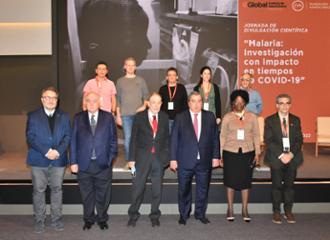Research projects
Start of main content
Immediate and universal diagnosis of infectious diseases based on optomechanical capillaries
20th national competition for scientific and technical research
Infection: early warning, prevention and treatment

Senior Researcher : Eduardo Gil Santos
Research Centre or Institution : Instituto de Micro y Nanotecnología - CNM - CSIC. Madrid
Abstract
Firstly, we carried out precise simulations for calculating the proper dimensions of the optomechanical capillary sensors that will be used throughout the project. The devices should have dimensions between 100 and 200 microns in length, and between 10 and 20 microns in diameter. In addition, they will possess localized microbubbles with diameters between 20 and 30 microns. The capillary wall thickness may not be less than 2 microns. In addition, we assembled a novel experimental system for manufacturing these devices from commercial silica microcapillaries. The manufacturing process consists of 2 steps. The first step consists of heating the commercial microcapillaries by means of a flame in a controlled manner, while they are stretched using micropositioners. This step allows reducing the diameter of the commercial capillaries from the initial 350 microns to a minimum of 6 microns. The second step consists of injecting nitrogen into the microcapillaries, while heating them too, which increases their internal pressure and gives rise to the formation of localized microbubbles having a diameter in between 15 and 50 microns. By regulating the stretching time, the power of the flame, the nitrogen pressure and its injection time, it is possible to control the final dimensions of the devices. Later on, this experimental system has been modified by replacing the flame with a CO2 laser. This system allows controlling the generated heat and its location more precisely, thus, the dimensions of the bubbles generated. Finally, an experimental system has been set up that will allow characterizing the mechanical and optical modes of the sensors, while bacteria flow inside them. The system consists of tunable near-infrared lasers, spectrum analyzers and flow controllers.
-
 Activities related
Activities related
-
 Projects related
Projects related
-
 News related
News related
-
 Publications related
Publications related
 Activities related
Activities related
-
6
Oct
2022
Coloquio online CÓDIGO SEPSIS: Su repercusión en la Salud de los españoles ONLINE www.fundacionareces.tv/directo, Thursday, 6 October 2022, 19:00 hours
-
19
Oct
2022
Jornada online Secuencia genética de los virus ONLINE www.fundacionareces.tv/directo, Wednesday, 19 October 2022, 19:00 hours
-
20
Feb
2023
Panel Discussion Infecciones de Transmisión Sexual: situación en España Madrid, Monday, 20 February 2023, 17:00 hours
 Projects related
Projects related
- Development and Application of saRNAs for the Treatment of Rare Monogenic Diseases 2024 Senior Researcher : María Luisa Cayuela Fuentes
- CHANNELOSOME RESCUING PEPTIDES IN THE TREATMENT OF ARRHYTHMIAS IN INHERITABLE HEART DISEASES 2024 Senior Researcher : José Jalife Research Centre or Institution : Centro Nacional de Investigaciones Cardiovasculares (CNIC). Madrid
- Mechanisms for sustaining mitochondrial genome integrity and function during hematopoiesis. 2024 Senior Researcher : Ana Victoria Lechuga Vieco Research Centre or Institution : Fundació Clínic per a la Recerca Biomèdica. Hospital Clínic. Barcelona
 News related
News related
-

Investigación con impacto contra la malaria, una urgencia de salud pública continua
Published on 04/06/2022
 Publications related
Publications related


End of main content



